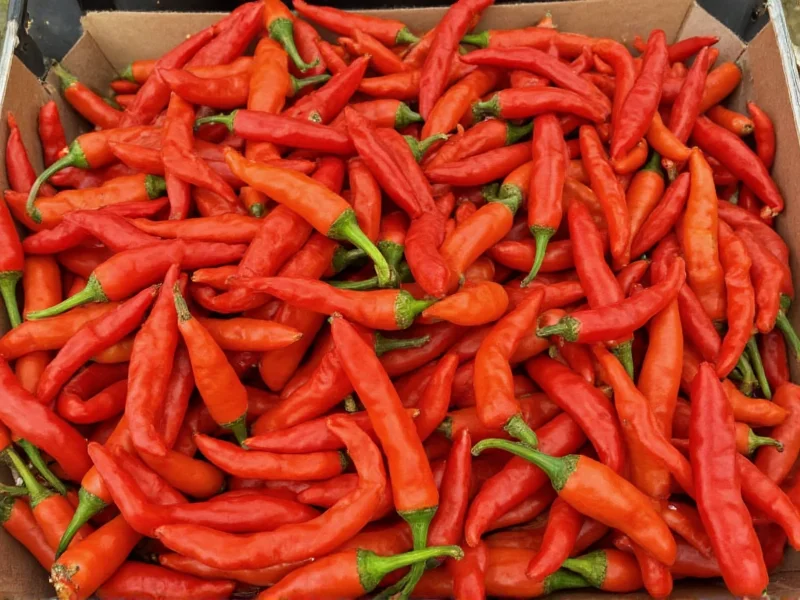Preserving your homegrown or seasonal peppers through drying extends their shelf life while concentrating their flavor. Whether you're working with jalapeños, habaneros, or bell peppers, proper drying technique makes all the difference in maintaining quality. This comprehensive guide details the most reliable methods for drying peppers at home, backed by practical experience in food preservation.
Why Dry Peppers?
Drying transforms fresh peppers into versatile pantry staples. The process removes moisture that causes spoilage while intensifying flavor compounds. Properly dried peppers retain 90% of their capsaicin (the compound responsible for heat) and essential oils that give each variety its distinctive character. Unlike freezing, dried peppers require minimal storage space and can last 1-3 years when stored correctly.
Pepper Selection and Preparation
Start with fresh, firm peppers free from blemishes or soft spots. Peak-season peppers contain optimal moisture content for drying. Wash thoroughly and pat completely dry before processing. For best results:
- Slice peppers lengthwise into 1/4-inch strips for even drying
- Remove seeds and membranes if you prefer milder heat (these contain most capsaicin)
- Leave small peppers like chiltepins whole
- Blanch thick-skinned varieties like bell peppers for 2 minutes to speed drying
Comparing Drying Methods
Four primary techniques exist for drying peppers at home, each with distinct advantages:
| Method | Time Required | Temperature | Flavor Preservation | Best For |
|---|---|---|---|---|
| Food Dehydrator | 8-12 hours | 125°F (52°C) | Excellent | All pepper types, especially thin-walled varieties |
| Oven Drying | 6-10 hours | 140°F (60°C) | Good | Small batches when dehydrator unavailable |
| Air Drying | 2-4 weeks | Ambient | Fair | Thick-stemmed peppers like cayenne |
| Sun Drying | 3-7 days | Ambient | Poor | Dry climates with low humidity |
Food Dehydrator Method (Recommended)
For the best way to dry peppers at home, a food dehydrator delivers consistent results. Arrange pepper slices in single layers on trays without overlapping. Set temperature to 125°F (52°C) and allow 8-12 hours for complete drying. Rotate trays periodically for even airflow. Peppers are properly dried when they snap crisply rather than bending.
This method for drying peppers preserves volatile flavor compounds better than higher-heat alternatives. The controlled environment prevents case hardening (where exterior dries too quickly, trapping interior moisture) that commonly occurs with oven drying.
Oven Drying Technique
When a dehydrator isn't available, oven drying provides a viable alternative for drying peppers for long term storage. Preheat oven to its lowest setting (ideally 140°F/60°C). Place pepper slices on wire racks over baking sheets to allow air circulation. Prop oven door open 2-3 inches using a wooden spoon to maintain proper airflow.
Check every 2 hours and rotate trays. Total drying time ranges from 6-10 hours depending on pepper thickness and oven accuracy. This oven drying vs dehydrator comparison shows dehydrators provide more consistent results, but ovens work acceptably for small batches.
Air and Sun Drying Options
Air drying works well for preserving pepper flavor when drying thick-stemmed varieties like cayenne. Thread peppers through stems onto cotton string, leaving space between peppers. Hang in a warm, dark, well-ventilated area away from direct sunlight. Complete drying typically takes 2-4 weeks.
Sun drying requires extremely dry conditions (humidity below 60%) and temperatures above 85°F (29°C). Place peppers on mesh screens elevated off the ground. Cover with cheesecloth to protect from insects. Turn daily. This method risks inconsistent drying and potential mold growth in humid climates.
Testing for Complete Dryness
Properly dried peppers should exhibit these characteristics:
- Brittle texture that snaps when bent
- No visible moisture when broken
- Darkened but not blackened color
- Leathery feel for thicker varieties like poblanos
Under-dried peppers may develop mold during storage. If any flexibility remains, return to the dehydrator for additional drying time. How long to dry peppers depends on variety and method, but never rush the process for proper preservation.
Storage Techniques for Maximum Shelf Life
Store dried peppers properly using these steps:
- Cool completely at room temperature (1-2 hours)
- Place in airtight glass jars or vacuum-sealed bags
- Add oxygen absorbers for storage beyond 6 months
- Store in a cool, dark place (70°F/21°C or below)
- Label with variety and date
For best flavor retention, use within 1 year. Properly stored dried peppers maintain heat level and flavor significantly better than store-bought alternatives. Check monthly for any signs of moisture or mold.
Using Your Dried Peppers
Reconstitute dried peppers for sauces and stews by soaking in hot water for 20-30 minutes until pliable. For grinding into powder, ensure peppers are completely dry before processing in a spice grinder. Whole dried peppers work well in soups and stews—simply add directly to the pot.
When substituting dried for fresh peppers in recipes, use a 1:3 ratio (1 dried pepper equals approximately 3 fresh). Remember that drying concentrates capsaicin, so adjust quantities based on your heat tolerance.
Troubleshooting Common Issues
Problem: Peppers developing mold during drying
Solution: Increase airflow, reduce humidity in drying area, or slightly raise temperature
Problem: Peppers becoming too dark or burnt
Solution: Lower temperature and check more frequently
Problem: Inconsistent drying (some pieces dry faster)
Solution: Slice peppers to uniform thickness and rotate trays regularly











 浙公网安备
33010002000092号
浙公网安备
33010002000092号 浙B2-20120091-4
浙B2-20120091-4